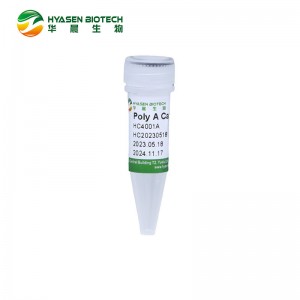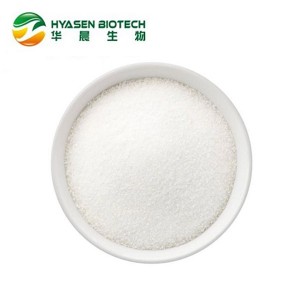
Double-stranded RNA (dsRNA) ELISA kit
This kit is an Enzyme-Linked Immunosorbent Assay (ELISA) coupling with biotin-Streptavidin system, for quantitative measurement of dsRNA with length above 60 base pairs(bp), regardless of the sequence. The plate has been pre-coated with anti-dsRNA antibody. dsRNA present in the sample is added and binds to antibodies coated on the wells. And then biotinylated anti-dsRNA antibody is added and binds to dsRNA in the sample. After washing, HRP-Streptavidin is added and binds to the Biotinylated anti-dsRNA antibody. After incubation unbound HRP-Streptavidin is washed away. Then TMB substrate solution is added and catalyzed by HRP to produce a blue color product that changed into yellow after adding acidic stop solution. The density of yellow is proportional to the target amount of dsRNA captured in plate. The absorbance is measured at 450 nm.
Application
This kit is for quantitative measurement of residual dsRNA.
Kit components
|
|
Components |
48T |
96T |
|
1 |
Elisa Microplate |
8×6 |
8× 12 |
|
2 |
Biotinylated Detection Antibody (100x) |
60μL |
120μL |
|
3 |
HRP-Streptavidin (100x) |
60μL |
120μL |
|
4 |
Dilution Buffer |
15mL |
30mL |
|
5 |
Tmb Substrate Solution |
6mL |
12mL |
|
6 |
Stop Solution |
3mL |
6mL |
|
7 |
Concentrated Wash Buffer (20x) |
20mL |
40mL |
|
8 |
Standard (UTP, 5ng/μL) |
7.5μL |
15μL |
|
9 |
Standard (pUTP,5ng/μL) |
7.5μL |
15μL |
|
10 |
Standard (N1-Me-pUTP, 5ng/μL) |
7.5μL |
15μL |
|
11 |
Standard (5-OMe-UTP, 5ng/μL) |
7.5μL |
15μL |
|
12 |
STE Buffer |
25mL |
50mL |
|
13 |
Plate Sealer |
2 pieces |
4 pieces |
|
14 |
Instruction Manual and COA |
1 copy |
1 copy |
Storage and Stability
1. For unused kit: The whole kit could be stored at 2~8℃ in shelf life. Strong light should be avoided for storage stability.
2. For used kit: Once the microplate is opened, please cover unused wells with plate sealer and return to the foil pouch containing the desiccant pack, zip-seal the foil pouch and return to 2~8℃ as soon as possible after use. Other reagents should be returned to 2~8℃ as soon as possible after use.
Materials Required But Not Supplied
1. Microplate reader with 450±10nm filter (better if can detect at 450 and 650 nm wavelength).
2. Microplate shaker.
3. RNase-free tips and centrifuge tubes.
Operation Flowchart
Before You Begin
- Bring all kit components and samples to room temperature (18-25℃) before use. If the kit will not be used up in one time, please only take out strips and reagents for present experiment, and leave the remaining strips and reagents in required condition.
- Wash buffer: dilute 40mL of 20× concentrated wash buffer with 760mL of deionized or distilled water to prepare 800mL of 1× wash buffer.
- Standard: briefly spin or centrifuge the stock solution before use. The concentration of four standards provided is 5ng/μL. For UTP and pUTP dsRNA standards, please dilute the stock solution to 1, 0.5, 0.25, 0.125, 0.0625, 0.0312, 0.0156, 0pg/μL with STE buffer to draw the standard curve. For N1-Me-pUTP dsRNA standards, please dilute the stock solution to 2, 1, 0.5, 0.25, 0.125, 0.0625, 0.0312, 0pg/μL with STE buffer to draw the standard curve. For 5-OMe-UTP dsRNA standard, please dilute the stock solution to 4, 2, 1, 0.5, 0.25, 0.125, 0.0625, 0pg/μL with STE buffer to draw the standard curve. We recommend standards can be diluted as following charts:
For UITP and pUTP dsRNA standards
|
No. |
Final Con. (pg/μL) |
Dilution instruction |
|
|
STE buffer |
standard |
||
|
|
100 |
49μL |
1μL 5ng/μL standard |
|
A |
1 |
495μL |
5μL100pg/μLsolution |
|
B |
0.5 |
250μL |
250μL solution A |
|
C |
0.25 |
250μL |
250μL solution B |
|
D |
0. 125 |
250μL |
250μL solution C |
|
E |
0.0625 |
250μL |
250μL solution D |
|
F |
0.0312 |
250μL |
250μL solution E |
|
G |
0.0156 |
250μL |
250μL solution F |
|
H |
0 |
250μL |
/ |
|
N1-Me-pUTP dsRNA standards
For 5-OMe-UTP dsRNA standard
|
||||||||||||||||||||||||||||||||||||||||||||||||||||||||||||||||||||||||||||||||||||
- Biotinylated detection antibody and HRP-streptavidin working solution: briefly spin or centrifuge the stock solution before use. Dilute them to the working concentration with dilution buffer.
- TMB substate: aspirate the needed dosage of the solution with sterilized tips and do not dump the residual solution into the vial again. TMB substate is sensitive to light, don’t exposure TMB substrate to light for a long time.
Using protocol
1. Determine the number of strips required for the assay. Insert the strips in the frames for use. Remaining plate strips not used in this assay should be repacked in the bag with desiccant. Close the bag tightly for refrigerated storage.
2. Add 100μL each of dilutions of standard, blank and samples into the appropriate wells. Cover with the plate sealer. Incubate for 1hr at room temperature with shaking at 500rpm. The samples should be diluted with STE buffer to appropriate concentration for accurate assay.
3. Wash step: Aspirate the solution and wash with 250μL wash buffer to each well and let it stand for 30s. Discard wash buffer completely by snapping the plate onto absorbent paper. Totally wash 4 times.
4. Add 100μL of biotinylated detection antibody working solution into each well. Cover with the plate sealer. Incubate for 1hr at room temperature with shaking at 500rpm.
5. Repeat wash step.
6. Add 100μL of HRP-streptavidin working solution into each well. Cover with the plate sealer. Incubate for 30min at room temperature with shaking at 500rpm.
7. Repeat wash step again.
8. Add 100μL of TMB substrate solution into each well. Cover with the plate sealer. Incubate for 30 min at R.T. Protect from light. The liquid will turn blue by the addition of substrate solution.
9. Add 50μL of stop solution into each well. The liquid will turn yellow by the addition of stop solution. Then run the microplate reader and conduct measurement at 450nm immediately.
Calculation of Results
1. Average the duplicate readings for each standard, control, and samples and subtract the average zero standard optical density. Construct a standard curve with absorbance on the vertical(Y) axis and dsRNA concentration on the horizontal(X)axis.
2. It is recommended to perform the calculation with computer-based curve-fitting software such as curve expert 1.3 or ELISA Calc in a 5 or 4 parameter non-linear fit model.
Performance
1. Sensitivity:
lower limit of detection: ≤ 0.001pg/μL (for UTP-, pUTP-, N1-Me-pUTP-dsRNA), ≤ 0.01pg/μL (for 5-OMe-UTP-dsRNA).
lower limit of quantitation: 0.0156 pg/μL (for UTP-, pUTP-dsRNA), 0.0312 pg/μL (for N1-Me-pUTP-dsRNA), 0.0625 pg/μL (for 5-OMe-UTP-dsRNA).
2. Precision: CV of Intra-Assay ≤10% , CV of Inter-Assay ≤10%
3. Recovery: 80%~ 120%
4. Linearity: 0.0156-0.5pg/μL (for UTP-, pUTP-dsRNA)0.0312 - 1pg/μL (for N1-Me-pUTP-dsRNA), 0.0625- 1pg/μL (for 5-OMe-UTP-dsRNA).
Considerations
1. TMB reaction temperature and time is critical, please control them according to the instruction strictly.
2. In order to achieve good assay reproducibility and sensitivity, proper washing of the plates to remove excess un-reacted reagents is essential.
3. All the reagents should be mixed thoroughly prior to use and avoid bumbles during sample or reagents addition.
4. If crystals have formed in the concentrated wash buffer(20x), warm to 37℃ and mix gently until the crystals are completely dissolved.
5. Avoid assay of samples containing Sodium Azide (NaN3), as it could destroy the HRP activity resulting in under-estimation of the amount of dsRNA.
6. Avoid RNase contamination during assay.
7. The standard/sample, detection antibody and SA-HRP can also be conducted at R.T. without shaking, but this may cause detection sensitivity decrease by one-fold. For this case, we recommend UTP and pUTP dsRNA standards should be diluted from 2pg/μL, N1-Me-pUTP dsRNA standards should be diluted from 4pg/μL and 5-OMe-UTP dsRNA standard should be diluted from 8pg/μL. In addition , incubate HRP-streptavidin working solution for 60min at room temperature. Do not use flask shaker, because flask shaker may result in inaccurate result.
Typical result
1.Standard curve data
|
concentration (pg/μl) |
N1-Me-pUTP modified dsRNA standard |
|||||
|
OD450-OD650(1) |
OD450-OD650(2) |
AVERAGE |
||||
|
2 |
2.8412 |
2.7362 |
2.7887 |
|||
|
1 |
1.8725 |
1.9135 |
1.8930 |
|||
|
0.5 |
1.0863 |
1. 1207 |
1. 1035 |
|||
|
0.25 |
0.623 |
0.6055 |
0.6143 |
|||
|
0. 125 |
0.3388 |
0.3292 |
0.3340 |
|||
|
0.0625 |
0. 1947 |
0. 1885 |
0. 1916 |
|||
|
0.0312 |
0. 1192 |
0. 1247 |
0. 1220 |
|||
|
0 |
0.0567 |
0.0518 |
0.0543 |
|||
2. Standard curve calculation
3.Liner detection range: 0.0312- 1pg/μL
|
Concentration (pg/μl) |
OD450-OD650 |
|
1 |
1.8930 |
|
0.5 |
1. 1035 |
|
0.25 |
0.6143 |
|
0. 125 |
0.3340 |
|
0.0625 |
0. 1916 |
|
0.0312 |
0. 1220 |
4. Test example
|
|
Sample concentration in assay |
OD450 - OD650 |
Calculated dsRNA concentration |
Result judgement |
|
M6 (1989 ng/μL) |
2ng/μl |
2.395 |
1.46 |
invalid |
|
0.5ng/μl |
1. 104 |
0.50 |
valid |
|
|
0. 1ng/μl |
0.325 |
0. 12 |
valid |
|
|
M13 (1394 ng/μL) |
2ng/μl |
2.029 |
1. 11 |
invalid |
|
0.5ng/μl |
0.703 |
0.29 |
valid |
|
|
0. 1ng/μl |
0. 194 |
0.06 |
valid |














